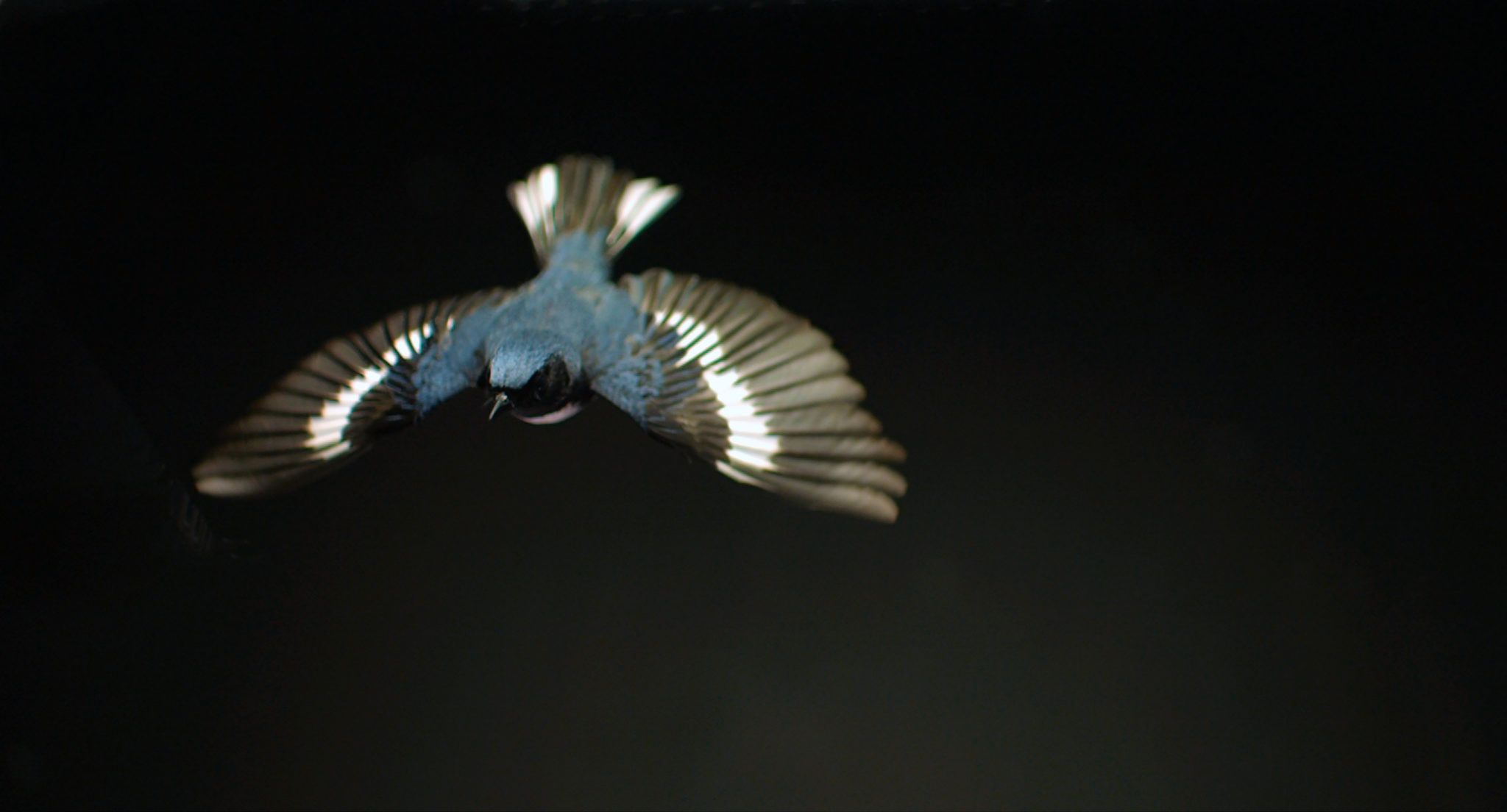
New research finds decreasing lit windows could reduce bird collisions by 60%. A black-throated blue warbler is pictured from “The Messenger” documentary, Songbirdsos.com
Building lights are a deadly lure for the billions of birds that migrate at night, disrupting their natural navigation cues and leading to deadly collisions. But even if you can’t turn out all the lights in a building, darkening even some windows could be a major lifesaver for birds.
Research published June 7 in Proceedings of the National Academy of Sciences found that over the course of 21 years, one building in Chicago sustained 11 times fewer nighttime bird collisions during spring migration and six times fewer collisions during fall migration when only half of the building’s windows were illuminated, compared to when all windows were lit. Colorado State University Assistant Professor Kyle Horton is a co-author on the study, which was led by Benjamin Van Doren, a postdoctoral researcher at the Cornell Lab of Ornithology.
In the study, the factors that had the strongest effect on bird collisions were the intensity of the migration, the wind direction and area of illuminated windows. The researchers also calculated that if half of the building’s windows had been darkened during peak migration periods, bird kills would have been reduced by around 60% over the past two decades.
“The sheer strength of the link between lighting and collisions was surprising,” said Van Doren. “It speaks to the exciting potential to save birds simply by reducing light pollution.”
Researchers from the Cornell Lab, Field Museum in Chicago, CSU, University of Massachusetts, and University of Michigan examined bird data from McCormick Place, a three-story convention center in the eastern section of Chicago from 2000 to 2020, or over 21 years. At the heart of the study were the records of over 40,000 dead birds – including when they were killed, which window, and what species – collected at the convention center since 1978.
CSU’s Horton leads research on effects of light on migratory birds
Assistant Professor Kyle Horton is one of the country’s leading experts on the effects of cities as ecological traps for migrating birds. Earlier this year, he received a $780,000 award from NASA, one of nine projects funded by the agency’s Biological Diversity program, to support his work.
He will team up with Michigan State University’s Geoffrey Henebry, professor in the Department of Geography, Environment, and Spatial Sciences and the Center for Global Change and Earth Observations.
The new project will focus on urban areas in the Central Flyway, primarily in the Great Plains.
“The value of these collections cannot be overstated,” said CSU’s Horton. “They provide a wealth of information, only realized through tireless, year in and year out monitoring. Such detailed collections are few and far between, indispensable in forming our understanding of migratory bird interactions with buildings and light pollution.”
Since 2000, these records have also included information about which windows bays were illuminated when each bird kill happened. By comparing this data from McCormick Place with other potential collision-risk factors such as weather conditions, moonlight and migration intensity, researchers teased apart which conditions were deadliest for migrating birds.
Building strikes kill hundreds of millions of birds a year, and many of these occur at night and during the migration seasons, when hundreds of species of songbirds are moving across the hemisphere under the cover of darkness. In response, a growing number of “lights out” initiatives and green building guidelines call for reductions in lighting during migration. The results of the study strengthen the science behind these programs by showing that darkening windows can directly reduce bird mortality.
Researchers also aim to engage people in lights-out efforts with local migration alerts, which give advance warning of nights with large bird migration events.
“Although permanently reducing light pollution is the ultimate goal, we hope to raise awareness through BirdCast migration forecasts,” said Van Doren. “Our forecasts predict the nights when large numbers of migrating birds will be at risk and turning off lights is critically important.”
BirdCast is a collaborative project between the Cornell Lab of Ornithology, CSU and University of Massachusetts.
Previous studies have shown that lights on buildings can attract and disorient migrating birds, and that the skyglow from cities can attract birds, shifting migration routes toward urban areas. A 2018 study found that Chicago is the highest-ranked U.S. city for light pollution exposure risk to night-migrating birds. As many as 100 million birds pass through the greater Chicago area in the spring, and over 150 million in the fall.
Ben Winger, an assistant professor and curator at the University of Michigan and a senior author on the research, said one of the powerful things about this study is that it confirms a number of phenomena that have been observed, but not previously quantified.
“We identified specific weather conditions during which collisions happen more frequently,” said Winger. “But the importance of illumination from the building emerged as a very important part of the story.”
The study also speaks to the importance of natural history collections in documenting global change.
“These collision data are even more valuable because they are backed up by specimens that are available for study in the Field Museum,” Winger said. “This will allow future scientists to go a step further in connecting different aspects of avian biology to the hundreds of millions of birds killed each year by window strikes.”
Dave Willard, now collections manager emeritus at the Field Museum, started collecting dead birds around McCormick Place in 1978, and hopes that having a data-driven analysis of the hazards of nocturnal lighting can help inform positive change in the ways cities build and the ways buildings use their lights at night.
“This paper brings together weather, radar and bird-collision data and shows unequivocally that reduced building lighting at night can substantially reduce bird fatalities,” he said.